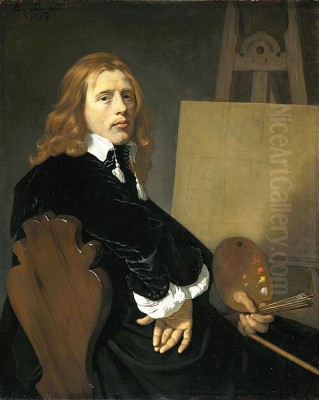
Paulus Potter stands as a remarkable figure in the rich tapestry of Dutch Golden Age painting. Active during the mid-17th century, he carved a unique niche for himself as a master painter and etcher, renowned primarily for his sensitive and highly realistic depictions of animals within meticulously rendered landscapes. Despite a tragically short life, Potter's innovative approach and technical brilliance left an indelible mark on the history of art, particularly within the specialized genre of animal painting, known as animalier painting. His work continues to be celebrated for its observational acuity, its profound empathy for the natural world, and its quintessential Dutch character.
Early Life and Artistic Formation
Paulus Potter was born in Enkhuizen, a town in North Holland, and baptized on November 20, 1625. Artistry ran deep in his family. His father was Pieter Symonsz Potter (c. 1597–1652), a painter of some note himself, specializing in landscapes, genre scenes, and occasionally historical subjects. His mother, Aechtie Potter (née Bartsius), was the sister of Willem Bartsius, another painter, further immersing the young Paulus in an artistic milieu from his earliest days. This familial connection to the craft undoubtedly provided him with initial exposure and, likely, his first lessons in drawing and painting.
The Potter family did not remain in Enkhuizen for long. By 1628, they had relocated to Leiden, a prominent university city. In 1631, they moved again, this time settling in the bustling metropolis of Amsterdam, the vibrant heart of the Dutch Republic's cultural and economic life. It was in Amsterdam that Paulus likely received more formal training, building upon the foundations laid by his father. While concrete documentation is scarce, art historians suggest potential influences or tutelage from painters like Nicolaes Moeyaert, known for his historical and biblical scenes often featuring animals, and perhaps Jacob de Wet, whose workshop was active in Haarlem but whose influence might have reached Amsterdam.
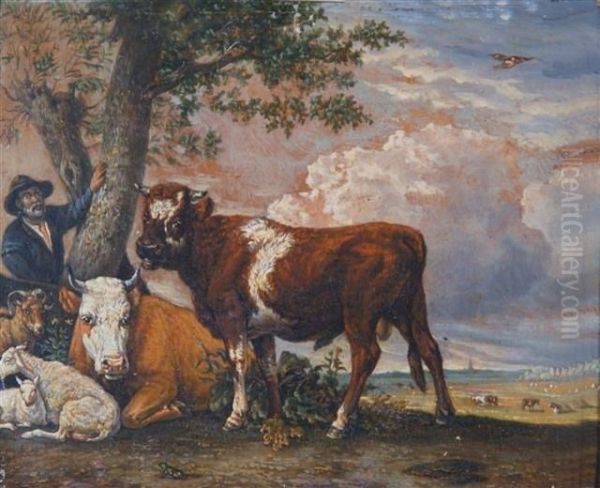
Regardless of his specific teachers, it is clear that Potter quickly absorbed the technical skills necessary for his craft. His early works show a developing hand, but already hint at the keen observational powers that would become his hallmark. Unlike many contemporaries who might have looked primarily to Italianate models or established Dutch masters, Potter seemed drawn from the outset to the direct study of nature, particularly the livestock that populated the Dutch countryside.
Developing an Independent Style in Delft
By his early twenties, Paulus Potter was establishing himself as an independent master. A significant step in his professional life occurred in 1646 when, at the age of 21, he was admitted into the prestigious Guild of Saint Luke in Delft. Membership in the guild was essential for artists wishing to sell their work and take on apprentices within the city. Delft, at this time, was another thriving center for the arts, fostering a climate of innovation, particularly in genre painting and perspective studies, soon to be exemplified by artists like Carel Fabritius and Johannes Vermeer (though Potter's time in Delft predates Vermeer's most famous works).
Potter's period in Delft, though relatively brief (lasting until 1649), was crucial for the consolidation of his artistic identity. It was here that he truly began to specialize in the animal paintings that would define his career. He moved away from the more varied subjects his father tackled, focusing intently on depicting cattle, horses, sheep, and goats with unprecedented realism and psychological depth. His paintings from this period show a growing confidence in composition and a mastery of rendering textures – the rough hide of a bull, the soft wool of a sheep, the damp earth of a pasture.
His approach was grounded in meticulous observation. Contemporary accounts suggest Potter spent considerable time sketching outdoors, directly observing animals in their natural habitats. He captured not just their physical forms but also their characteristic postures, behaviours, and interactions. This dedication to firsthand study set him apart and imbued his work with a sense of authenticity that resonated with the Dutch appreciation for the tangible, observable world.
The Hague: Recognition and Maturity
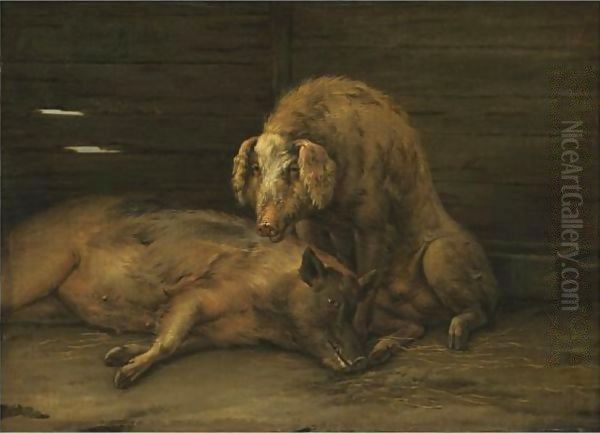
In 1649, Potter relocated once more, this time to The Hague, the administrative center of the Dutch Republic and home to the court. This move signaled a step up in his career ambitions. In The Hague, he continued to refine his craft and gained significant recognition. He lived near the prominent landscape painter Jan van Goyen, though their styles differed considerably, with Potter focusing more on the inhabitants of the landscape than the panoramic vistas favored by Van Goyen. The artistic community in The Hague also included figures like Adriaen van de Venne.
It was during his time associated with Delft and shortly before or upon arriving in The Hague that Potter created what is arguably his most famous work: The Young Bull (1647). Now housed in the Mauritshuis in The Hague, this monumental painting, almost life-sized, caused a sensation. Its sheer scale was unusual for an animal portrait, elevating the subject—a young, powerful bull, accompanied by a cow, a sheep, a lamb, and a farmer—to a level typically reserved for historical or religious themes. The painting is a tour-de-force of realism, with every detail, from the bull's wet nose and bristly hide to the buzzing flies and meticulously rendered foliage, captured with astonishing precision.
The Young Bull became an emblem of Dutch art and national identity, celebrating the country's agricultural prosperity and its connection to the land. While later critics sometimes found its realism almost too literal, its impact during Potter's lifetime and in subsequent centuries was immense. It cemented his reputation as the leading animal painter of his generation. In 1650, while in The Hague, Potter married Adriana van Balckeneynde, the daughter of a leading building contractor, further integrating him into the city's prominent circles.
Amsterdam and Final Years
Despite his success in The Hague, Potter was lured back to Amsterdam in 1652. This move was reportedly encouraged by Dr. Nicolaes Tulp, one of Amsterdam's most influential citizens. Tulp, a respected surgeon and mayor, is famously depicted in Rembrandt's The Anatomy Lesson of Dr. Nicolaes Tulp (1632). Tulp became an important patron for Potter, recognizing the painter's exceptional talent. It's important to note Tulp's role was primarily that of a patron and admirer, offering commissions and support, rather than artistic mentorship in the traditional sense.
Potter's return to Amsterdam placed him at the epicenter of the Dutch art world, alongside giants like Rembrandt van Rijn and his successful pupils such as Ferdinand Bol and Govert Flinck. While Potter's focus remained distinct, the competitive and stimulating environment likely pushed him further. His works from this final period maintain his high standards of detail and observation, sometimes incorporating more complex groupings of animals or exploring different lighting conditions.
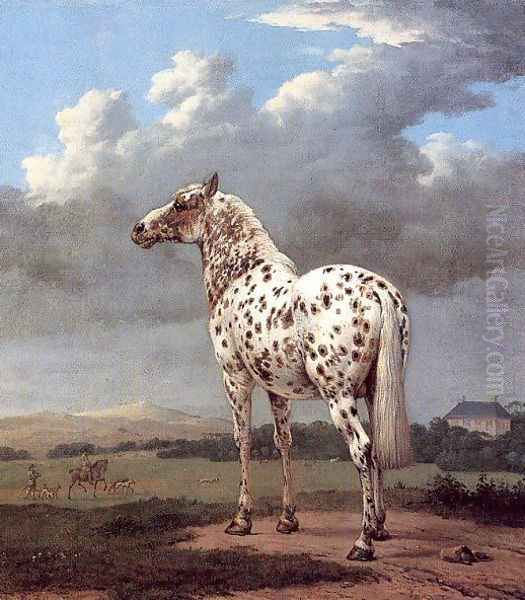
Tragically, Paulus Potter's flourishing career was cut short. He contracted tuberculosis, a disease that ravaged populations in the 17th century. Despite his illness, he continued to work, but his health rapidly declined. He died in Amsterdam in January 1654 and was buried on the 17th of that month. He was only 28 years old, leaving behind a relatively small but highly influential body of work produced over a career spanning little more than a decade.
The Art of Observation: Potter's Style and Technique
Paulus Potter's artistic style is characterized by its unwavering commitment to realism and meticulous detail. He approached animal painting with the same seriousness and intensity that portrait painters applied to human subjects. He sought to capture the individual character of each animal, moving beyond mere representation to convey a sense of presence and even sentience. This was a significant departure from earlier traditions where animals often served symbolic or secondary roles in compositions.
His technique involved careful drawing, precise brushwork, and a sophisticated understanding of light and shadow. Potter was a master at rendering textures: the coarse hair of cattle, the smooth coat of a horse, the fluffy wool of sheep, the rough bark of trees, and the dampness of the Dutch soil. He paid extraordinary attention to anatomical accuracy, capturing the musculature and skeletal structure beneath the hide. Tiny details, like insects crawling on a plant or the reflection in an animal's eye, add to the startling verisimilitude of his scenes.
Light plays a crucial role in Potter's paintings. He often depicted specific times of day, capturing the warm glow of late afternoon sun or the cool, clear light of morning. This sensitivity to atmospheric conditions enhances the naturalism of his work and creates a palpable sense of place. His landscapes, while often serving as backdrops for the animals, are rendered with care, depicting the flat, watery meadows, fences, and farm buildings typical of the Dutch countryside. This contrasts sharply with the idealized, often Italianate, landscapes favored by contemporaries like Jan Both or Nicolaes Berchem. Potter's vision was firmly rooted in his native land.
Masterworks: Beyond the Bull
While The Young Bull remains his most iconic painting, Paulus Potter produced numerous other masterpieces that showcase his skill and thematic range. Two Horses in a Field near a Fence (c. 1649), for example, displays his ability to capture the quiet companionship between animals in a serene, natural setting. The rendering of the horses' coats and musculature is exemplary.
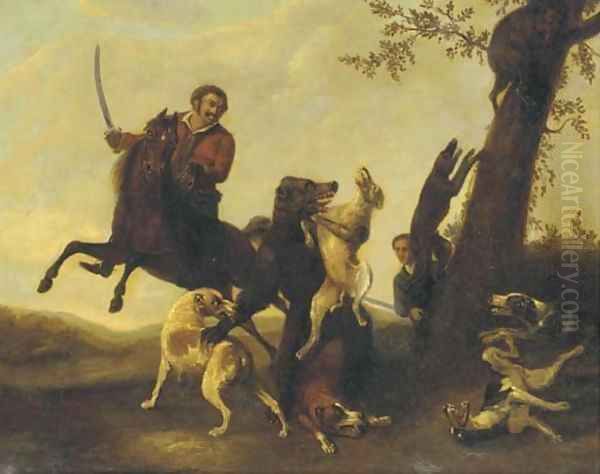
Figures with Cattle by a Barn (often dated around 1647) demonstrates his skill in composing larger groups, integrating human figures naturally within the pastoral scene. The interplay of light and shadow across the animals and the rustic architecture is handled with subtlety. Similarly, Two Pigs in a Sty (1649) finds dignity and painterly interest in the humblest of subjects, showcasing Potter's non-judgmental eye for detail across the animal kingdom.
Potter occasionally ventured into mythological or allegorical themes, such as Orpheus Charming the Beasts (1650). Even here, his primary interest seems to lie in the diverse array of animals gathered around the central figure, each rendered with characteristic care. Works like The Piebald Horse (c. 1650-54) highlight his mastery of depicting specific animal breeds and their unique markings, bathed in his signature atmospheric light. The Bear Hunt (c. 1649) shows a more dynamic and violent side of the animal world, demonstrating his versatility beyond peaceful pastoral scenes.
Potter's Place in the Dutch Golden Age
Paulus Potter emerged during a period of unprecedented artistic production in the Dutch Republic. The 17th century saw a burgeoning middle class with a strong appetite for art that reflected their lives, values, and environment. This led to a high degree of specialization among painters. While Rembrandt excelled in portraiture and historical scenes, and Vermeer captured intimate domestic interiors, Potter became the preeminent specialist in animal painting.
He elevated the genre beyond simple depictions of livestock. His work resonated with Dutch pride in their agricultural success and their reclaimed land. His contemporaries included other skilled painters who depicted animals, such as Aelbert Cuyp, known for his luminous landscapes often featuring cattle, Philips Wouwerman, who specialized in horses and battle scenes, and Adriaen van de Velde, who painted refined pastoral landscapes with elegant figures and animals. Yet, Potter's intense focus and psychological insight into his animal subjects remain distinctive.
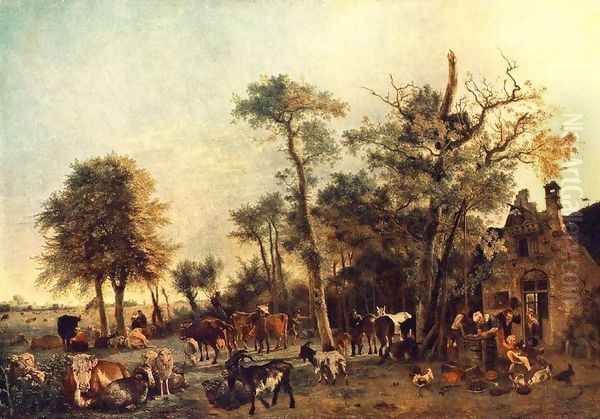
His commitment to realism aligns with a broader trend in Dutch art, seen also in the meticulous still lifes of Pieter Claesz or Willem Kalf, and the detailed genre scenes of numerous artists. However, Potter's specific contribution was to apply this detailed realism so profoundly to the animal world, treating cows and horses with the gravity previously reserved for humans or divine figures. There is no evidence of direct artistic collaboration or mentorship between Potter and giants like Rembrandt, but they inhabited the same artistic world, responding to similar market demands and cultural values, albeit with vastly different thematic focuses and stylistic approaches. Rembrandt learned from historical painters like Pieter Lastman, while Potter seemed to learn most directly from nature itself.
The Etchings of Paulus Potter
Beyond his celebrated paintings, Paulus Potter was also a highly accomplished etcher. His prints, though fewer in number than his paintings, demonstrate the same keen observation and technical finesse. He produced several series of etchings, primarily depicting cows, horses, and sheep, often shown individually or in small groups within simple landscape settings.
His etchings are admired for their fine lines, delicate tonal variations, and the skillful suggestion of texture and light using only black ink on paper. They possess an intimacy and directness that complements his painted work. Like his paintings, his etchings were popular and influential, circulating more widely than unique canvases could. They further solidified his reputation as a master observer of animal life and contributed significantly to the development of animal etching as a distinct genre. The sensitivity of his etched line captures the essence of the animals with remarkable economy and grace.
Legacy and Influence
Despite his death at the young age of 28, Paulus Potter's impact was substantial and enduring. He produced over 100 paintings in his short career, along with his significant body of etchings. His work was highly sought after during his lifetime and remained popular throughout the 17th and 18th centuries. The Young Bull, in particular, achieved legendary status, becoming one of the most famous paintings of the Dutch Golden Age, rivaling works by Rembrandt and Vermeer in public recognition, especially after its acquisition for the national collection displayed at the Mauritshuis.
Potter's influence extended well beyond the Netherlands. His realistic yet sensitive portrayal of animals provided a model for subsequent generations of animalier painters across Europe. In the 18th and 19th centuries, particularly in France and Britain, artists specializing in animal subjects looked back to Potter as a foundational figure. Painters like the English master George Stubbs, renowned for his anatomical studies of horses, and the French artist Rosa Bonheur, celebrated for her large-scale animal paintings, can be seen as heirs to the tradition Potter so brilliantly established.
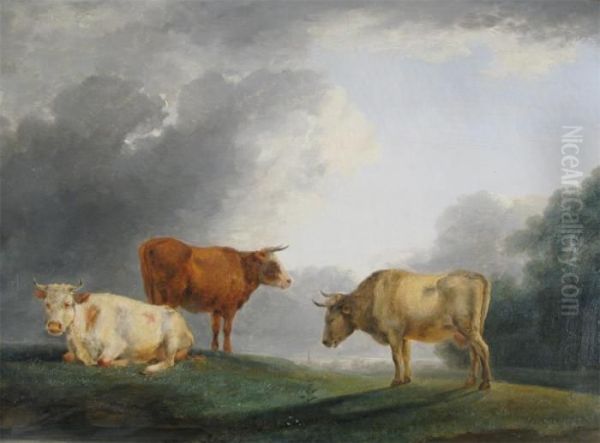
Paulus Potter's enduring legacy lies in his elevation of animal painting to a high art form. Through his intense observation, technical mastery, and empathetic portrayal of creatures great and small, he captured the beauty and dignity of the natural world, leaving behind a body of work that continues to fascinate and impress viewers with its timeless realism and profound connection to the Dutch landscape and its inhabitants. He remains a key figure for understanding the specialization, realism, and cultural values that defined the Dutch Golden Age of painting.